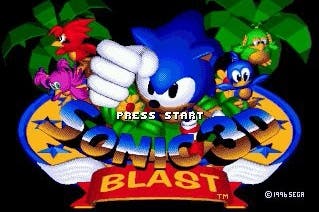Why the founder of Traveller's Tales released a director's cut of an old Sonic game 25 years later
Blast from the past.
By any conventional definition, Jon Burton has lived at least three careers: first, a multi-hyphenate founder-programmer-director at Traveller's Tales, best known as the scrappy studio behind a wide variety of licensed movie-games; second, a producer and director of films, primarily in the inescapable Lego mondo-franchise; and, now, a burgeoning YouTuber with nearly a hundred-thousand subscribers to his channel, Gamehut. And while it might seem like a wild leap to some, to hear Burton tell it, it's a natural outgrowth of his existing hobbies, which now includes remastering his old games.
"I was one of the first wave of people making video games, and I'm getting older, and I want to fiddle with stuff," he says. "At first, I just wanted to document all my old games, since all this physical media is going to be lost to time. I wanted to look back on the programming choices I made, and maybe exhibit some prototypes. I didn't do any promotion of the channel or anything. It was for my own entertainment, which is one of the best reasons to do things, if you ask me."
During the early days of Traveller's Tales - or "TT," as he refers to it - Burton was the studio's sole programmer, a role that he relished far more than his mundane managerial duties. After some early titles, TT worked with Sony on a string of licensed Disney games in the mid-to-late '90s, starting with Toy Story, one of the first to launch alongside its parent film - usually, the game would come six to nine months later. When the side-scrolling platformer racked up millions of sales - despite its now-infamous difficulty curve - TT discovered that timing was indeed everything. "We had found our business model, and people started to emulate it," recalls Burton. "For the next 10 years, we were on seven-month deadlines."

During that decade of flitting from half-year endeavor to half-year endeavor, Burton got a life-altering opportunity: Sega approached TT to make a Sonic game, which would eventually become the divisive Sonic 3D Blast. "That got our attention," Burton says. "It might be hard to believe now, but Sonic was the biggest thing in the world back then." Sega had already drawn up the design scheme for an isometric 3D game based around collecting colourful birds (eventually dubbed "Flickies" in an homage to earlier Sega games) to enter checkpoints, but since no-one had tried to make a platformer of that style on the aging Mega Drive, it lacked the manpower to construct the technology themselves. As Burton recalls, it was exactly the sort of technical challenge he thrives on. "I love making a machine do something you haven't seen it do," he says. "We made it the way they wanted from scratch, and I'm very proud of that."
During those frantic months, Burton tried to impress a Sega producer named Kats Sato with the Lotus Turbo Espirit sports car he drove at the time, to disastrous results. "Just before his hotel I thought I'd slow down to show him how fast the car accelerated. So I slowed to a crawl and noticed another car coming up behind us, so I thought I'd better take my chance to show off. So I accelerated away as quickly as I could and then slowed back down and pulled into the hotel car park. However, the car that had been coming up behind me just happened to be a police car.
"They thought I'd stolen the car and, having spotted them, was trying to make my escape. So I was chased into the hotel car park by sirens and blue flashing lights. Soon afterwards two more police cars joined the scene. So you have three police cars surrounding a very sheepish me, a very startled Kats, and the rest of SEGA's team staring out of the hotel windows at the commotion. Luckily for me, once I'd proved it was my car, they let me go with a warning. But still, pretty embarrassing in front of SEGA, even though a fairly fitting incident considering the selling point of Sonic games is speed."

As TT expanded its business, Burton was forced to pass the programming reins onto his employees, relegating himself to a more traditional "creative director" role. But now he's taken a step back from the games industry, Burton has begun to re-evaluate his decades-old portfolio from a new perspective. And though he stands by every one of the games TT developed over the years - yes, even A Bug's Life - he admits 3D Blast could use some tweaks. "I look at a lot of modern reviews, and there's a lot of obvious critiques of certain elements, like how you take damage when you're wearing the speed shoes, or the lack of incentive to get the medals. So I thought: why don't I just fix some of these things?"
Thus he began yet another career of sorts - Jon Burton, part-time mod-maker. At first, Burton tried to use a Game Genie to implement some of his most basic changes to the code, with limited success. Eventually, he realised he could just make a de facto "ROM hack" for the game and call it a free director's cut patch, for those who own the original cartridge. He unearthed old assets, created a wishlist of features he crowd-sourced from the community, and got to work. Unlike many ROM hacks, though, Burton deliberately boxed himself within the limits of the Mega Drive hardware itself, which made the process much more complicated than simply dropping new sprites into the existing code.
"It's like riding a bike," Burton explains. "I have to fit it into a 4-meg cart. Adding in Super Sonic was nine new sprites. Well, you only have 80 sprites to begin with. Adding in the score and time limit - both elements of other Sonic games - made the screen a little too busy, so I had to write special code to slide it on and off depending on what's going on. People ask me, 'can you add in the Saturn music?', and I say, 'well, do you understand the fundamental difference between how the Mega Drive and Saturn make music?' It's not easily interchangeable. Sonic Mania might look like a retro game, but there's no way the Mega Drive could have handled it. It's the same thing.
"I have people sending me beautiful Super Sonic transformation animations, really top-notch stuff, and I try to explain to them that I don't have the tools to compress the data anymore. Well, some people say they have converters that can do it, but I'm not sure. I'm not even sure I have the cartridge space, anyway. You see? It goes on and on. You can fiddle around forever."
Throughout our conversation, Burton always refers to his pet project as the "director's cut," and never one of the usual gaming terms for such a project, such as "remaster". To Burton, this distinction is incredibly important. After all, film auteurs alter their "finished" work all the time, and it usually sticks in the mind of the audience: hardly anyone watches the mangled theatrical cut of Blade Runner these days, for example. Still, these efforts are usually blessed by the studio that birthed them. In a field as young as gaming, the stark lines between developer and publisher become a bit muddier as the years go by. As the founder of the company that made 3D Blast, Burton knows he owns the code he's mucking with for a bit of fun. With other games, however, the equation isn't so simple. "As game developers get older, these issues are going to come up more and more," Burton says. "I don't think there's anything in my past that anybody is gonna really clamour to see. But I think a lot of developers do, and if they've left those companies, can they legally do it? I think there's a negotiation that has to take place there."
For now, with the director's cut finally released (the final version is now available on Steam Workshop, and as a downloadable patch file if you already own the original Mega Drive game), Burton plans to return to his YouTubing ways in his off-time, uploading prototypes and coding tricks he devised decades ago. Even now, months into it, he's still bewildered by their popularity.
"I thought nobody would watch it. Nobody would care about how a sound-chip works, or how I did some effect in a 25-year-old game. And they get hundreds of thousands of views. Me, waffling on about old technology in a bad British accent. It's a selfish endeavor. But if people enjoy it, that's all the better."











